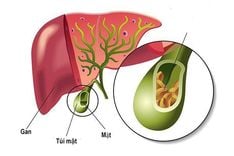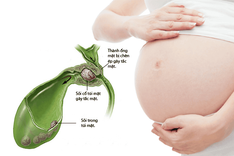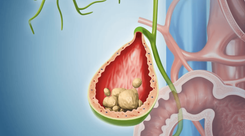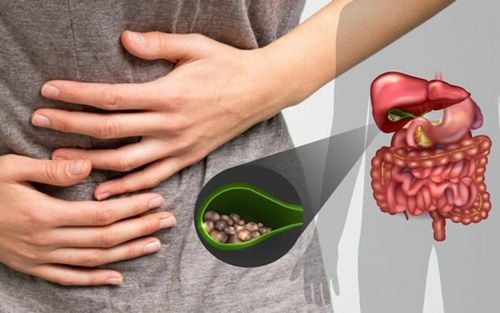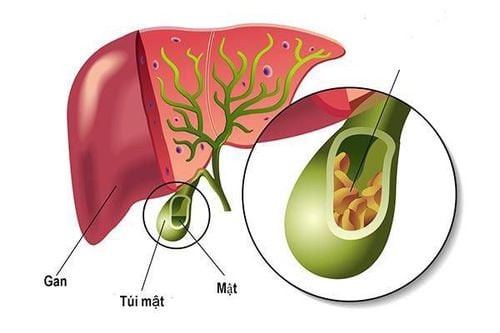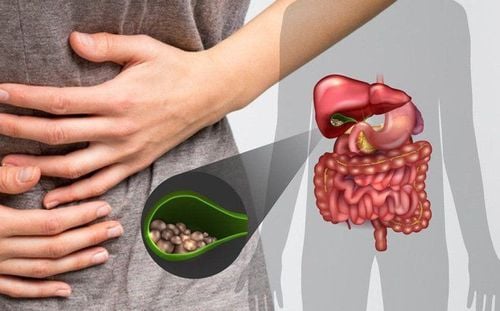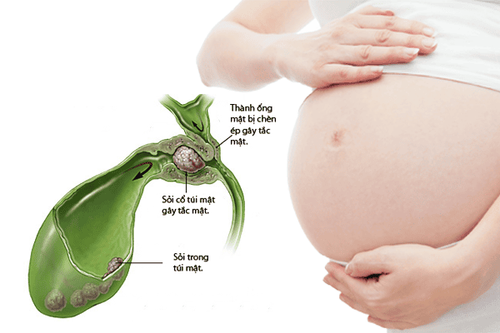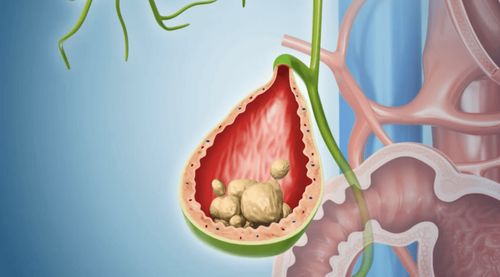The article is professionally consulted by Dr. Vo Thi Thuy Trang, Specialist I, Digestive Endoscopy Specialist at the Department of Outpatient & Internal Medicine, Vinmec International General Hospital Da Nang. Dr. Trang has many years of experience in the field of digestive endoscopy.
Bile duct stones are solid stones that form in the bile secretion system of the liver, including the gallbladder. If the stones are large and cause blockage, patients may experience intense pain in the upper right abdomen, sometimes requiring emergency surgery. On the other hand, bile duct stones can also cause elevated liver enzymes or liver enlargement, which may be detected through tests, even when the patient has no symptoms at all.
1. What are bile duct stones?
Bile duct stones form from deposits in bile, which contain enzymes that help digest fats and absorb certain vitamins. Bile is produced in the liver, secreted through bile ducts, and concentrated and stored in the gallbladder, a small pear-shaped organ under the liver, ready to be used during meals.
When solid substances in bile crystallize, possibly due to a blockage or bacterial involvement, bile duct stones can form. Most bile duct stones are very small, similar to grains of sand, but sometimes larger stones, like a golf ball, can be found in the gallbladder.
The majority of bile duct stones are primarily made of cholesterol. The rest, called pigment stones, are made of calcium salts and bilirubin, a breakdown product of red blood cells.
In terms of frequency, women are at a higher risk of developing bile duct stones than men. This is a result of female hormones. Estrogen increases cholesterol in bile, while progesterone slows the emptying of the gallbladder. As a result, before the age of 40, women are diagnosed with gallstones nearly three times more often than men.
However, by the age of 60, the risk for women is only slightly higher than for men. Additionally, estrogen therapy, such as birth control pills, increases the risk of bile duct stones, especially when taken in pill form rather than as a patch.
Obesity is another risk factor that increases the likelihood of bile duct stones, as the body contains more fat and produces more estrogen. Ironically, rapid weight loss also increases the risk, as a very low-calorie diet slows bile production and may cause more cholesterol crystallization.
Bile duct stones are also common in people with diabetes or any condition that reduces bowel or gallbladder contractions, such as spinal cord injury. Some evidence suggests a genetic predisposition for the formation of gallstones.

2. What are the symptoms of bile duct stones?
Most people with bile duct stones are unaware of their presence until symptoms occur. Bile duct stones often remain "silent" and can only be discovered incidentally through an ultrasound or CT scan performed for other conditions.
Symptoms of bile duct stones typically occur when the stones move through the bile ducts or cause a blockage at any point along the bile duct system. At this point, biliary pain (pain in the bile ducts) occurs. The pain tends to happen when the gallbladder contracts, usually in response to a fatty meal, in order to release bile into the duodenum for digestion. The pain is typically located in the upper or middle right side of the abdomen, near the liver.
The pain is most intense within the first hour and may last for several hours after eating. Sometimes, the pain can radiate to the back or right shoulder and may be accompanied by nausea and vomiting. The pain usually subsides as the gallbladder relaxes. However, it tends to recur during subsequent meals, especially after eating fatty foods. Over time, the patient may experience loss of appetite, poor eating, and weight loss.
However, if the stones cause a blockage in the bile ducts, more serious problems can occur, including acute cholecystitis (gallbladder inflammation), acute pancreatitis, acute cholangitis (bile duct inflammation), or acute hepatitis. Any of these conditions will present with severe pain and other symptoms such as jaundice (yellow skin), yellowing of the eyes, high fever, chills, and vomiting. At this stage, the patient needs to be hospitalized and treated promptly to prevent the infection in the bile ducts from spreading throughout the abdomen and causing peritonitis or bloodstream infection (sepsis).
3. Are the complications of bile duct stones dangerous?
The complications of bile duct stones can include:
- Cholecystitis: When a bile duct stone moves and gets stuck at the neck of the gallbladder, it can cause inflammation. The patient will experience severe pain in the upper right abdomen and a high fever.
- Common bile duct obstruction: Bile duct stones can block the bile ducts. Symptoms are similar to when a stone is stuck at the neck of the gallbladder, with severe abdominal pain, jaundice, and fever caused by infection in the bile ducts.
- Pancreatic duct obstruction: The pancreatic duct is a tube that runs from the pancreas and connects to the common bile duct just before it empties into the duodenum. A bile duct stone that moves to this area can block the pancreatic duct, potentially leading to acute pancreatitis. The patient will experience continuous severe abdominal pain, nausea, and often needs to be hospitalized immediately.
- Gallbladder cancer: People with a history of long-standing bile duct stones in the gallbladder have an increased risk of developing gallbladder cancer. This is a result of chronic inflammation over time.

4. How is bile duct stone diagnosed?
- Blood tests: Blood tests are used to evaluate liver enzymes, which can show elevated levels due to bile duct stones affecting both liver cells and bile duct endothelial cells. Additionally, when acute complications occur from a stone blocking the bile duct, blood tests can indicate infection, jaundice, pancreatitis, or other complications caused by gallstones.
- Abdominal ultrasound: This is the most commonly used imaging tool to check for the presence of stones in the bile ducts. It has relatively high sensitivity and specificity.
- Endoscopic ultrasound: This procedure can help identify smaller bile duct stones that might be missed during abdominal ultrasound. The process involves inserting an endoscope through the mouth, emitting sound waves to create a precise image of the surrounding tissue.
- Other imaging tests: Additional tests that can help detect bile duct stones include CT scans, magnetic resonance cholangiopancreatography (MRCP), or endoscopic retrograde cholangiopancreatography (ERCP). With ERCP, not only can bile duct stones be detected, but they can also be removed during the procedure.
5. How are bile duct stones treated?
Most people with bile duct stones who do not show symptoms do not require treatment.
Doctors will only recommend intervention if the bile duct stones cause clinical symptoms, such as liver pain, jaundice, fever, or if diagnostic tests show elevated liver enzymes.
Treatment methods for bile duct stones include:
- Gallbladder removal surgery: Doctors may recommend surgery to remove your gallbladder because bile duct stones are often located in the gallbladder and frequently recur. The gallbladder is also a non-essential organ. Gallbladder removal can be done through open surgery or laparoscopic surgery. Once the gallbladder is removed, bile will flow directly from the liver into the small intestine, rather than being stored in the gallbladder.
- Endoscopic retrograde cholangiopancreatography (ERCP) to remove stones: This is a diagnostic and therapeutic procedure. The doctor will cut the sphincter of the bile duct at the point where it drains into the duodenum to remove the stones.
- Medications to dissolve gallstones: There are some medications that can help dissolve gallstones. However, the treatment can take months or even years, and the stones may form again once the treatment is stopped. For this reason, medications are not commonly used and are reserved for patients who refuse surgery. Medications may also be preferred in cases where the stones are located within the bile duct system in the liver, rather than in the gallbladder or common bile duct, where surgery is more difficult. If non-surgical treatment does not improve the condition or if complications arise from the stones, surgery to remove the stones from the liver may be considered.
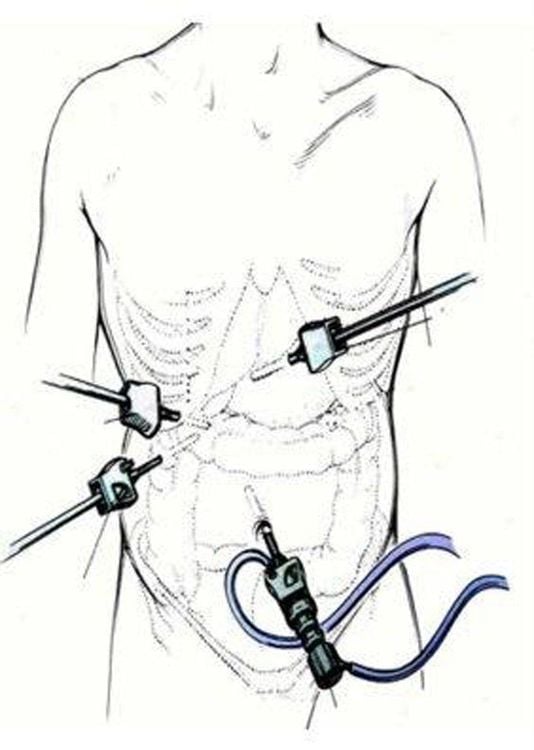
6. How to prevent bile duct stones?
You can reduce the risk of developing bile duct stones by:
- Not skipping meals: Try to stick to your regular eating schedule every day. Skipping meals or fasting can increase the risk of gallstones.
- Losing weight the right way: If you need to lose weight, aim for a gradual weight loss of about 0.5 to 1 kg per week. Rapid weight loss can increase the risk of gallstones.
- Eating more fiber-rich foods: Build your diet around fiber-rich foods like fruits, vegetables, and whole grains to help reduce the risk of gallstones.
- Maintaining a healthy weight: Being overweight or obese increases the risk of gallstones. Exercise to achieve a healthy weight by reducing calorie intake and increasing physical activity.
In summary, bile duct stones are not a rare condition. With the advancements in medicine, treatment methods for this condition have been highly effective, resolving the biliary pain that patients experience after each meal. Patients should undergo regular health check-ups to detect bile duct stones early, as they can lead to elevated liver enzymes or liver enlargement seen in ultrasounds. Early intervention can help prevent severe complications caused by bile duct stones.
Currently, Vinmec International General Hospital has applied the endoscopic retrograde cholangiopancreatography (ERCP) technique to treat conditions such as common bile duct stones, liver duct stones, Vater’s ampulla tumors, pancreatic head tumors, bile duct stenting, and nasobiliary drainage, with a success rate of over 98%.
To perform ERCP, Vinmec has equipped itself with a modern endoscopic system and the Endocut Electrosurgical Knife, which has the advantage of not causing pancreatitis or pancreatic reactions. To achieve success and minimize possible complications from this technique, the key factors are not only modern equipment but also the expertise and experience of the medical staff. The ERCP technique at Vinmec is performed by renowned doctors who are highly skilled, experienced, dedicated, and professional.
To arrange an appointment, please call HOTLINE or make your reservation directly HERE. You may also download the MyVinmec app to schedule appointments faster and manage your reservations more conveniently.
References: health.harvard.edu, unlockfood.ca, emedicinehealth.com, health.com, niddk.nih.gov


